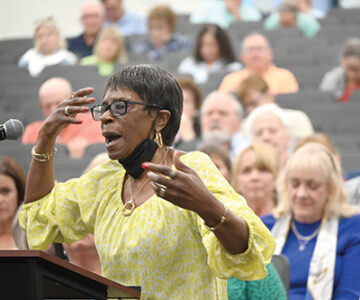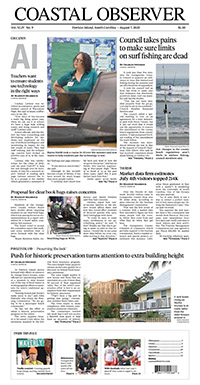Land use
Cheers turn to jeers when plan update passes

The cheers were short lived.
The audience that turned out last week to argue against the latest draft of Georgetown County’s future land use plan thought for a moment that the Planning Commission had agreed with them. But the hands that went up were voting against a motion to defer approval once again.
“If this is approved, you’re going to have a furious, furious public on the Waccamaw Neck,” commission member Marla Hamby said.
It was approved. The public was furious. Taunts and jeers filled the Howard Center auditorium. One woman made her way toward the stage where the commission sat, but stopped when a deputy took a step in her direction. Middle fingers were raised as people filed out. Deputies escorted the commission members to their cars.
Two dozen speakers at a second public hearing told the commission they believe the revised land use element of the county’s state-mandated comprehensive plan opens the door for increased population density on Waccamaw Neck. Some cited numbers produced by the citizen group Keep It Green at a forum earlier in the month that found changes in the land use maps that are part of the element would add over 5,000 units to those already envisioned by the current land use maps, which were adopted in 2007 and received minor adjustments in 2015.
“We hope you’ll have the courage to push the pause button on going forward,” Victoria Calder, a Murrells Inlet resident, said. “We could really use a moratorium.”
Donna Perry, a Litchfield resident, heard the figures from Keep It Green at the forum that filled the Waccamaw Library auditorium.
“It was sobering. There were audible gasps in the room in disbelief that this would even be proposed,” she said.
Packed meetings
The commission deferred a vote on the land use element in April so that the planning staff could get answers to questions posed about the plan during a public hearing that packed the meeting room in the old courthouse and led some people to be turned away because the facility was at capacity.
Last week’s meeting was moved to a larger space at the Howard Center. Over 200 people attended.
“When you have enough voices that are standing saying, ‘let’s take a step back,’ compared to those that are saying, ‘let’s move forward,’ I think you should take heed of that,” said Johnny Ford, who started the Parkersville Planning and Development Alliance.
Only two people spoke in favor of the plan.
Becky Ryon, north coast director of the Coastal Conservation League, said she liked the recommendations for “low impact development” and “conservation subdivisions” that would preserve open space. She said density in some rural areas could be even lower than proposed, suggesting one unit for every five acres in some places.
But she also cautioned that pushing development farther into the rural areas would create sprawl, “worsening traffic congestion and putting a strain on our infrastructure.”
The focus on affordable housing appealed to Geales Sands, who lives in Murrells Inlet and is executive director of the Bunnelle Foundation.
“Much of our workforce must travel here from Horry County because they cannot find affordable housing in Georgetown County, hence the traffic,” she said. “True conservationists know that density done correctly is a very good thing. It increases green space and makes it accessible to a broad audience as well as providing more affordable housing.”
But it was the overall population increase that concerned most speakers.
Marybeth Klein, who lives in Pawleys Plantation, said the 2007 land use element reflected that concern in two sections “that specifically state no more development on the Neck. If that was true in 2007, it is certainly no less true today.”
The current plan, which several speakers said should be tweaked rather than replaced, says, “the general concept of allowing higher density to prevent sprawl is no longer applicable in this area. The key now is to limit the number of new residential units that are added.”
Two pages later, it says “density increases in new development should only be allowed if open space is provided by the use of planning tools.”
The sections, pages 23 and 25, aren’t included in the proposed update, Klein said.
Holly Richardson, the county planning director, said the exact wording isn’t the same, but the concepts are included in the update.
“It supports those goals and even goes beyond that and gives us tools and methods to achieve those goals,” she said.
Those include reducing the maximum density level from 16 to 12 units per acre and preserving 50 percent of the land that’s currently undeveloped as green space.
“This plan says low and medium density residential are the predominant land use on the Waccamaw Neck,” Richardson said.
She also noted that the density limits otherwise remain unchanged. So too does the building height limit of 35 feet, which speakers at last month’s hearing said would lead to three story “high rises.”
Late changes
The maps that accompany the plan were changed after the April commission meeting to show Founders Club and Litchfield Country Club golf courses as “conservation-agriculture” areas instead of “residential.” The Murrells Inlet Marsh Walk was changed to “commercial corridor” from “village center,” after people said they feared condos would replace the area’s restaurants.
Other tracts were also changed to show lower future development densities, Richardson said.
But she also noted that the changes to the future land use maps don’t equal a change to the zoning.
“This plan is not a zoning plan. This plan won’t change anybody’s zoning,” Richardson said.
The county has included $200,000 in the planning department budget for the coming fiscal year to rewrite the zoning ordinance.
Richardson also said that comparing the 2007 future land use maps with those in the updated plan is not accurate.
“This probably is an area where we’re likely to have some disagreement,” she said. “The most accurate comparison is to compare the current zoning and what’s allowed today to the proposed land use.”
Along Highway 17, the “general commercial” zoning district allows residential development of up to four units an acre or one unit in addition to a commercial use.
The Keep It Green analysis showed commercial areas changing from no residential development to four units an acre.
Cindy Person, chief counsel for Keep It Green Advocacy, said the commission needed to do its own comparison before approving the update to the land use element. She said the recent changes were minimal.
“At best, this plan is a shot in the dark that profoundly misses the target,” she said. “A worst, it’s a deliberate effort to correct a huge problem created by a decade’s work of overdevelopment and zoning approvals that are severely out of alignment with the current comprehensive land use plan.”
Person represents citizens groups and neighbors in four lawsuits that challenge county land use approvals based in part on a claim that they didn’t follow the comprehensive plan. Three of those suits were dismissed and are on appeal.
Coming to a vote
Elizabeth Krauss, who chairs the commission, pointed out that the update has been in progress for five years. Work on the current draft began last year after the county hired consultants to do the work.
“It’s time for us to consider that the plan does pave the way for many of the ordinance improvements – the zoning ordinance needs improvement – that we’ve been talking about for years: wetlands protection, cultural overlays for vulnerable neighborhoods, more open space, low impact design, new zoning districts, reducing density and providing affordable housing incentives,” she said.
The maps and the goals and objectives need to be considered as a whole, Krauss added.
“I still believe that the proposed plan and future land use maps substantially increase density in the Waccamaw Neck,” Hamby said. “It definitely does not include the language from pages 23 and 25 that I insisted on over and over again from the very beginning.”
She moved to defer approval until the commission could get information about all the parcels on Waccamaw Neck where density on the future land use map would increase compared with the current maps.
After a pause, commission member David Roper provided a second. “I’d list to see some of the parcels that we still have on the Neck,” he said.
Krauss confirmed with Richardson that the data wasn’t readily available. It would take a couple of weeks for the consultants to produce it and it would come with an additional cost, Richardson said.
“There won’t be any expense at all to the county,” Hamby said.
The GIS specialist that did the work for Keep It Green already has most of the data. “You just need to look at them and see if you agree.”
Krauss suggested that was something County Council could do once it received the approved plan from the commission.
The vote to defer failed 3-4, with Hamby and Roper joined by Robert Davis.
The vote to approve the draft passed 4-3, with Krauss joined by Zannie Graham, Jefferson Linnen and Ashley Nelson.
The land use element now requires three readings from County Council, which will also hold another public hearing.




